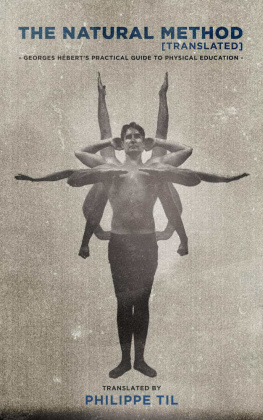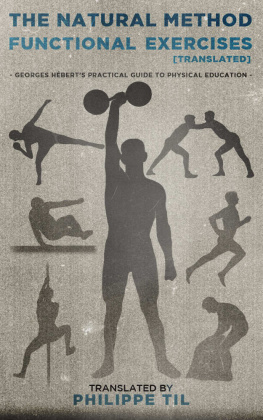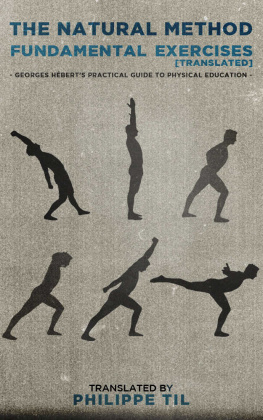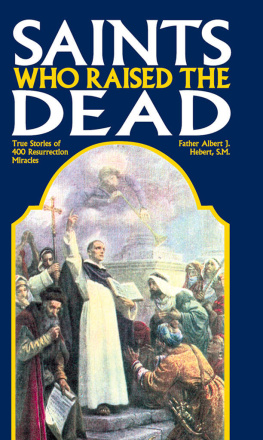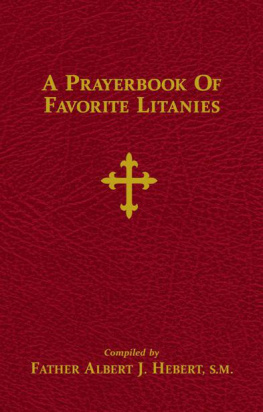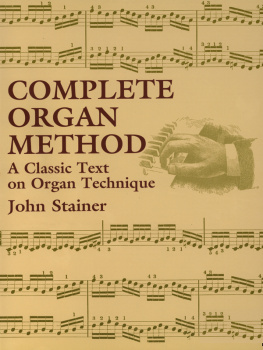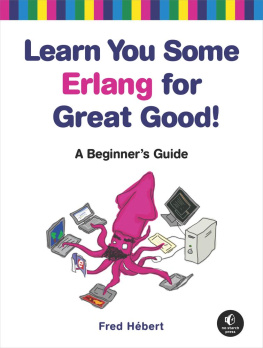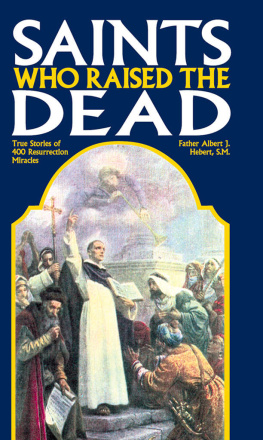THE NATURAL METHOD
(Translated)
Contents
Acknowledgements
The content of this book is easily a few hundred years old, as the translated work itself is based off already then known ways to train, which can date as far back as the Antiquity. Fitness began as military/martial training (for the goal of warfare). Roman legionnaires or the Barbarian hordes they would fight come to mind, while others can be found on decorative documentation (prior to the existence of manuscripts) on vases for instance. Below is an Etruscan vase depicting a trainer, recognizable by his forked staff, with annotations pertaining to the importance of a trainer in those times.


Athletic contests were central to the ancient life as part of religion and funerary rituals. Estruscans frequently decorated their tombs with brightly painted panels that often depicted athletic subjects. This image of a trainer to the right belonged to a much larger scene that was probably painted in such a tomb.
At the prompting of Dr Ed Thomas, I took it upon myself to translate the original works. French being my native tongue, it made sense to combine my culture with my profession, capturing language and training nuances at once. This is the first of three books, with each subsequent book more content rich than the first. Consider this first book the exposition to the method outlined by Hbert. Once again, while many of the exercises and training ways are not new, at the time, the structuring of the method through fieldtesting into a comprehensive, scalable and adaptable system is what gives this practical guide its value.
I found it particularly interesting that the methods outlined in the book (published in 1909) have run parallels in other countries, notably Germany and Sweden, as well as in the USA with the works of Stan LeProttis program at the LaSierra High School, whose program was adopted throughout the United States after an appearance on the Tonight Show in 1962. I have myself received education throughout my professional career as a trainer in Russian methods with Pavel Tsatsouline. Many stem from military training, as it was a functional way to get individuals fit for combat.
The Natural Method, a Practical Guide to Physical Education has no other goal than to allow the individual to develop into a completely functional athlete. The incidental, welldefined and balanced muscular development, the associated sense of discipline and civic duty, instant readiness for action is the ultimate goal of the method. This is not a book outlining how to add inches to your pecs or biceps, or how to deadlift twice your bodyweight or cut 30lb of fat in 30 days, which are single-minded goals. There is no hype or marketing, just a simple, scalable and methodical way for a person of sane mind and body to achieve their athletic potential. Some might even call it tactical.
With the advent of technological comforts, an increasingly sedentary lifestyle (already presented as an issue in the beginning of the 20th century) resulting in a regression of our physical fitness paired with the removal of humans from the food chain (a massive upgrade as comedian Louis C.K. likes to point out), the need for fitness on a daily basis is gone. However, it is vital to our health to seek that development. Hbert doesnt just focus on the physical development of the body from an aesthetic or functional standpoint, he also promotes the civil duty of the individual in order to be able to defend family, community and ultimately, country. This constitutes the Noble Cause, which this book is only a part of. With the assistance of my own peers and their parallel research, the goal is to share the knowledge and make it as widely available as possible.
My desire to undertake the massive task of translating Hberts work is my personal duty and choice, with no goal for actual profit. The information belongs in the public domain and I encourage you to share this information with anyone interested. The low cost of the book has only the goal of making the information accessible in English, any revenue is purely a bonus. Why not make it completely free? Simply because without at least some assigned value, there is little incentive or commitment from the reader to complete the reading. It is out of respect for Georges Hbert, who truly pioneered physical education.
PREFACE
Hberts master thought when writing the Practical Guide to Physical Education was to compose, or more precisely codify a method, a practical system with complete physical perfection* as final educational goal, by the most effective, quickest and simplest means.
(*Translators note: the perfecting of the physical body through abilities and symmetrical,balanced muscular development. There is a subtle nuance in the French language where the word improvement and the root of the word perfect are degrees apart, as one isintended to lead to the other, improvement being the path to perfection)
The method hereby presented is not a theoretical essay, meaning it was not composed ata desk. Quite the opposite, it was taught and practiced in the field; it is the outcome of a daily and personal practice over five years dedicated to the physical education of thousands of subjects of all ages, all builds, all occupations and origins, broken down intothe following:
5000 subjects from 17 to 25 years of age (School of Marine Fusiliers of Lorient)
2000 subjects from 14 to 17 years of age (Brest maritime school)
Several hundred children ages 7 to 14, active in sports.
This method has yielded sufficient evidence of its merits. Its excellent results, officially observed in the naval military schools, ended up being approved and adopted as astandard in the Navy.
 Apparatus height: high elevation for high standards of performance.
Apparatus height: high elevation for high standards of performance.It is however important to stress that the exercises that go along with the method are notnew. Through the ages and countries where physical culture has been honored, theexecution of the exercises has been nearly identical, give or take a few variations. For instance, trunk flexion and extension, running, jumping, swimming etc. share the same platform. Nearly all types of exercises have been tried and applied.
Moreover, progress in physical education doesnt consist of inventing movements of aspecific nature, rather to distinguish, by experimentation, meaning a precise knowledgeof their effects, which of them are the best exercises; to appropriately combine and blendthem in order to reach, as quickly as possible, physical perfection; in the end, it mainly consists of a better way to train.
The Method comprises:
1)A Basics portion, made up of eight groupings of exercises, called functionalbasics, which consist of: marching, running, jumping, swimming, climbing, lifting,throwing, defense by natural means.
2)A Preparatory portion, where exercises with specifically targeted benefits for thevarious body parts can be found, consisting of: all the simple and combinedmovements of the arms, legs and trunk, facilitated by the normal function of thejoints, suspension work, supported work, balance work, hopping/jumping andbreathing.

